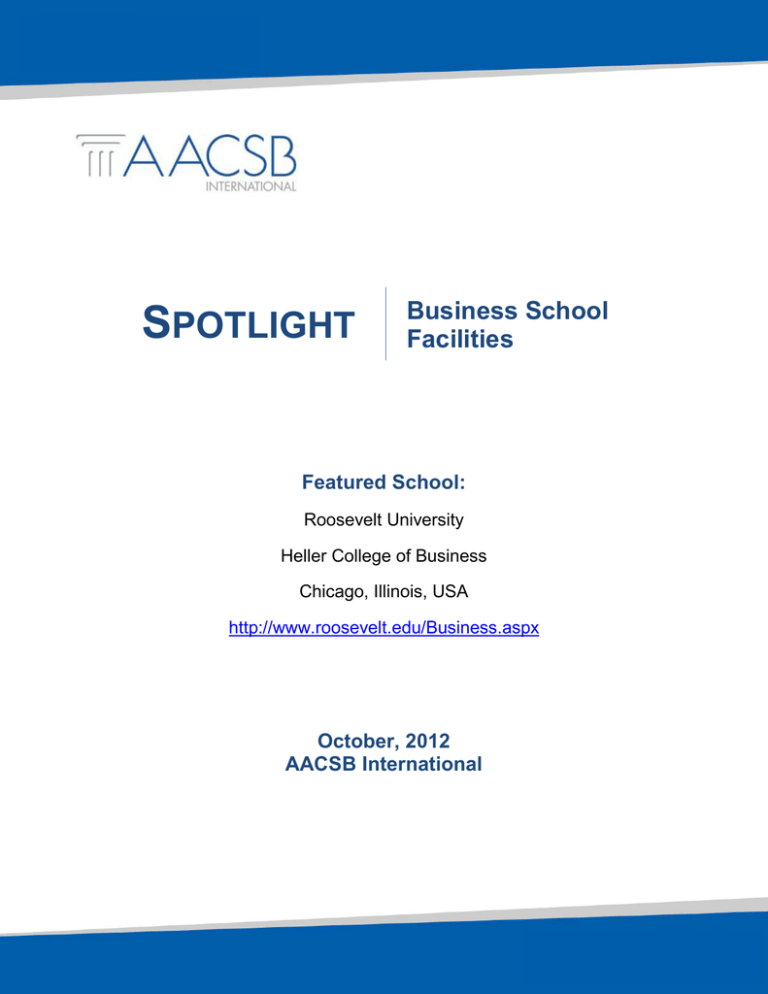
SPOTLIGHT
Business School
Facilities
Featured School:
Roosevelt University
Heller College of Business
Chicago, Illinois, USA
http://www.roosevelt.edu/Business.aspx
October, 2012
AACSB International
SPOTLIGHT | Business School Facilities
Roosevelt University | 2
Wabash Vertical Campus
Construction Began: May 2010
Open for Business: March 2012
Size: 414,585 square feet
Floors: 32
Cost: 128 million USD
Architectural Firm: VOA Associates
Construction Firm: Power Construction Co.
More Information: http://www.roosevelt.edu/CampusCommunity/Wabash/WabashTour.aspx
Background:
On May 5, 2012, Roosevelt University in Chicago opened the second tallest university building in the
country (behind the Cathedral of Learning at the University of Pittsburgh) and the sixth tallest academic
building in the world. The Wabash Building is referred to as a Vertical Campus because its laboratories
and classrooms, student life facilities and residential housing are all in one tall building in an urban
setting. Featuring a unique undulating shape with blue-green glass, the building is a dramatic new
addition to Chicago’s famous skyline.
Features:
•
Offices: Admissions office; financial aid office; faculty
and administrative offices
•
Classrooms: Seven conventional classrooms (seating
36 or fewer), three tiered classrooms (seating 60 to 80),
and three auditorium classrooms (seating 78 to 108); 6
breakout rooms allow for student teams of 10 or fewer to
meet outside of the tiered classrooms
•
Other: School bookstore; fitness center; residence
floors for students; trading floor; dining center; 2
boardrooms (seating 20) designed for board meetings
and seminars
The Wabash Building is 469 feet tall and is constructed on a
very small site, only 100 feet across and 170 feet deep. The
Wabash Building connects in five places to Roosevelt
University’s signature building, the Auditorium Building, a
national historic landmark completed in the late 1880s.
© AACSB International. All Rights Reserved.
SPOTLIGHT | Business School Facilities
Roosevelt University | 3
The first six floors of the building are devoted to student life activities. For the convenience of prospective
students, the offices of admission, financial aid and advising are on the first floor and mezzanine. The
bookstore is also on the first floor and in the basement, while a comprehensive dining center with seating
for 300 people is on the second floor. Other floors contain offices and meeting rooms for student
organizations and a fitness center with exercise and weight lifting equipment.
The Vertical Campus has beds for 633 students on floors 15 through 31. To enter the residence floors,
th
students take an elevator to the 14 floor where they must pass a security booth and electronic turnstiles
to gain entrance to the residential floors via separate elevators.
Unique to the Heller College of Business are two classrooms referred to as “learn labs” designed by
Steelcase based on research on how students live and learn on campuses. These Learn labs have
$250,000 USD in technology including 4 Interactive White boards called Eno Boards.
th
On the 12 floor one classroom will have Cisco Systems Telepresence technology that will allow for
teleconferencing with overseas locations or businesses during class.
Green Building
From the onset, the Wabash Building was
designed as a green building and Roosevelt
expects to receive a Silver or perhaps a Gold
LEED-certification from the U.S. Green
Building Council. Some of the features that
make this building green are a bike storage
facility for 130 bikes; over 51% of the roof
space has native plants; construction
materials that were 20% recycled; energy
efficient heating and air conditioning
equipment; low volatile organic compound
paints, mastics, glues and caulks; and
recycled content carpets and other materials.
Fun Fact
The Fine Arts Annex, a small office building
formerly situated to the north of the vertical
campus, was torn down, but it's façade has
© AACSB International. All Rights Reserved.
SPOTLIGHT | Business School Facilities
Roosevelt University | 4
been preserved and incorporated into the Wabash building's design. The façade was created by Andrew
Rebori, a renowned Chicago architect. Matching the 100-year-old terra cotta was one of the most
challenging parts of the construction. The façade is now the entrance to the University’s bookstore at the
north end of the Wabash Building.
Acknowledgements: AACSB International is grateful for the assistance of Terri Friel, Dean of the Walter
E. Heller College of Business
© AACSB International. All Rights Reserved.





